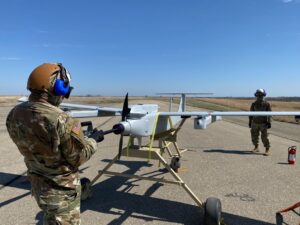On the one year-mark of Russia’s invasion of Ukraine, the U.S. has approved a new $2 billion weapons aid package that includes plans to supply Kyiv with additional munitions and new drone systems.
The new deal includes capabilities to be procured from industry with Ukraine Security Assistance Initiative (USAI) funds and likely to be delivered on longer-term timelines, with officials on Friday reiterating the U.S.’ commitment to continued support for Kyiv’s security requirements.

“Today’s solemn anniversary is an opportunity for all who believe in freedom, rules, and sovereignty to recommit ourselves to supporting Ukraine’s brave defenders for the long haul—and to recall that the stakes of Russia’s war stretch far beyond Ukraine,” Defense Secretary Lloyd Austin said in a statement.
The new USAI package includes plans to supply Ukraine with more ammunition for Lockheed Martin [LMT]-built HIMARS launchers, additional 155mm artillery rounds, counter-drone and electronic warfare detection equipment, mine clearing equipment, secure communications support equipment and funding for training, maintenance, and sustainment, according to the Pentagon.
The weapons aid deal will also cover delivery of new drone systems for Ukraine: the K8 UAS built by North Carolina-based CyberLux, which specializes in small quadcopters, Anduril’s Altius-600, which the Army has used as a prototype for its Air Launched Effects (ALE)-Small, as well as AeroVironment’s [AVAV] Switchblade 600 extended-range loitering munition and the company’s Jump 20 UAS, that the Army has selected for the first increment of a program to help find a replacement for the service’s RQ-7B Shadow drone.
Air Force Brig. Gen. Patrick Ryder, the Pentagon’s press secretary, told reporters the “munitions for laser-guided rocket systems” included in the package are BAE Systems’ Advanced Precision Kill Weapon Systems (APKWS).
“So, essentially [they provide] the ability to convert unguided rockets into precision guided munitions which can be operated from various launchers that we’re providing to the Ukrainians. So that’s about as specific as I’m going to be able to get,” Ryder said during a press briefing on Friday.
L3Harris’ [LHX] Vampire counter-drone system, which was included in an earlier USAI package for Ukraine, can be equipped to fire APKWS-converted rockets or other laser-guided munitions (Defense Daily, Aug. 26 2022).
Ryder said it’s unlikely the capabilities included in Friday’s package will be in Ukraine to support the potential offensive operation this spring.
“As has been the case, we’ll continue to work very closely with industry to try to get [the capabilities] there as quickly as we can,” Ryder said. “Again, we’re already providing [Ukraine] with a significant amount of capabilities coming from [Presidential Drawdown Authority packages] along with the international community to get them the capabilities they need for the springtime. And again, this is a fight that will continue to be tough so we want to make sure not only are we meeting their immediate needs but we’re also meeting their medium and long-term needs.”
Following the ninth gathering of the U.S.-led Ukraine Defense Contact Group with defense officials from 54 countries in Brussels last week, Austin detailed efforts among the group to bolster Kyiv’s capabilities ahead of a potential spring offensive (Defense Daily, Feb. 14).
Austin said Friday the members of the Ukraine Defense Contact Group have committed more than $20 billion in security assistance to Ukraine to date, “including hundreds of tanks, thousands of other armored vehicles, vital air-defense systems, hundreds of artillery systems, and other crucial capabilities.”
The U.S. has announced more than $32 billion in security assistance to Ukraine since the start of Russia’s invasion, which Austin noted include commitments for “more than 1,600 Stinger anti-aircraft systems, more than 8,500 Javelin anti-armor systems, 232 howitzers and more than two million rounds of artillery ammunition, 38 HIMARS launchers and ammunition a Patriot air-defense battery, eight National Advanced Surface-to-Air Missile Systems (NASAMS) and other key air-defense capabilities, 109 Bradley infantry fighting vehicles, 31 Abrams tanks and 90 Stryker armored personnel carriers.”
Ryder on Friday also addressed reports on the potential for China to supply lethal assistance to Russia, saying the Pentagon assesses Beijing has not done so “yet.”
“But we also have noticed that they haven’t taken it off the table. So you’ve heard Secretary Austin, Secretary Blinken and others warn China about the implications of providing lethal assistance to Russia, to include needlessly extending this conflict and the suffering of the Ukrainian people,” Ryder said.
John Kirby, spokesman for the White House’s National Security Council, said earlier on Friday that Iran has now provided Russia artillery and tank rounds, along with drones supplied previously, with Tehran seeking to purchase new military equipment from Moscow, to potentially include fighter jets.